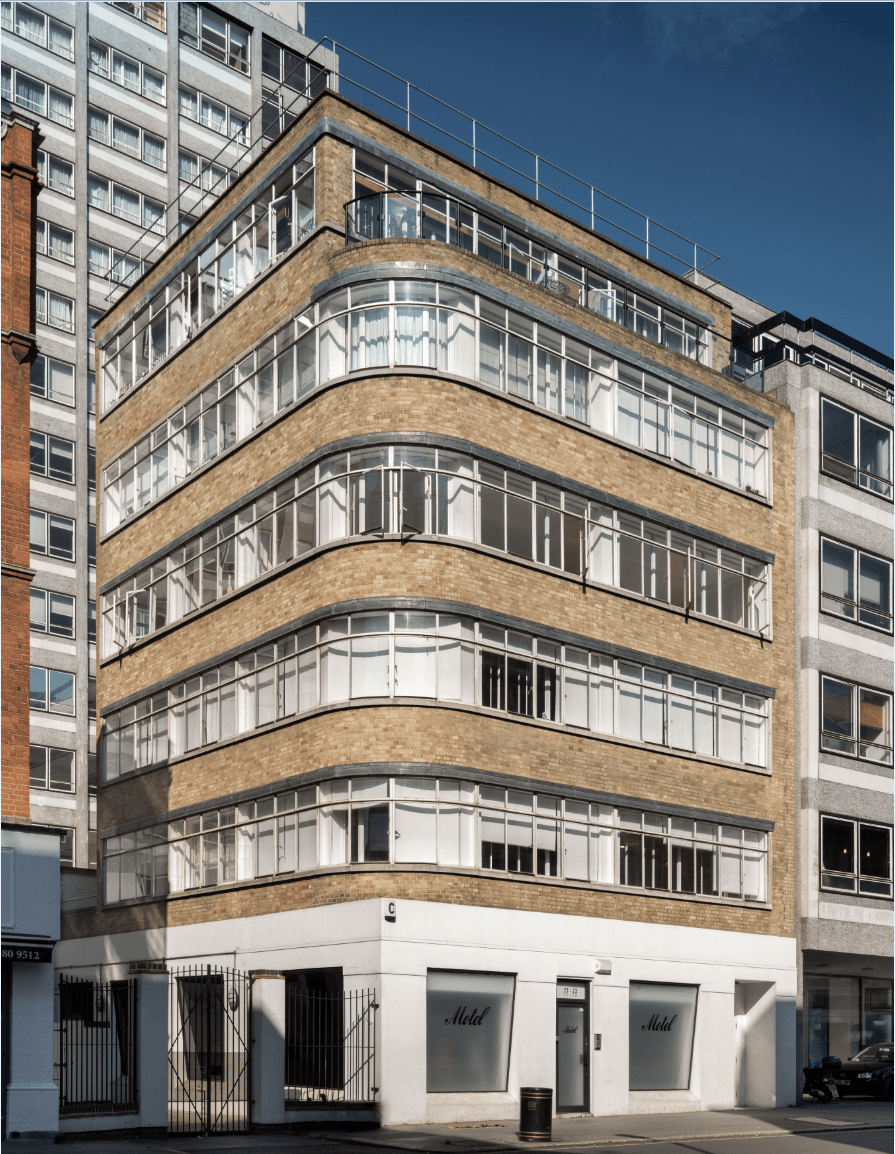71–73 Great Portland Street
By the Survey of London, on 28 April 2017

71-73 Great Portland Street, Joseph Emberton, architect, 1937. Photographed for the Survey of London by Chris Redgrave © Historic England
This building is a little known work by Joseph Emberton, showrooms of 1937 that would have been more boldly Modernist but for compromises that arose from the fact that the freehold of this entire street block was held by the Crown.
The site’s leaseholder from 1920 was Julius Turner (born Tanchan), who lived at 58 Portland Place and was a major figure in Great Portland Street’s motor trade through his control of Thorns. Turner stutteringly converted two shops for motor showrooms, first dubbed Crown Motors. In 1927 he asked the Crown Commissioners for a building lease at 71–77 Great Portland Street, wanting to build a ‘magnificent Motor Showroom’. He was rebuffed. Trouble had been caused by his parking and washing of cars, ‘Mr Turner (who is a naturalized Polish Jew) is not a particularly desirable tenant’. A second approach in 1929 also failed, but a more modest proposal for refurbishment of Nos 71–73 for Thorns gained approval in 1931. Turner then fell ill, suffering what was called a nervous breakdown in 1933. He returned to the fray in 1934, submitting new plans for rebuilding Nos 71–73 as motor showrooms below workrooms and offices. His architect now was Emberton, and the scheme was bold.
H. Meadows, the Commissioners’ architect, commented that ‘The proposed design conforms to present day architectural ideas of simplicity and utility. It is in contrast with its surroundings and for this reason is somewhat incongruous. The flat surfaces of the façade to the upper storeys in one plane rests apparently on the glass of the shop fronts of the ground floor and this has the effect of making the building appear to be lacking in adequate support. This is particularly emphasised on the angle of the building which is shown as a solid mass of walling unsupported by a curved plate-glass window.’ Told that the Crown could not object much more than to ask that ‘they adopt small letters instead of the monsters’, Meadows persevered in shriller terms: ‘the design violates the canons of good architectural composition by failing to satisfy the eye that the structure is self-supporting and therefore structurally sound … [it is] lacking in the element of apparent truthfulness, which is the indispensable quality of all good architecture. The proposals are of a revolutionary character architecturally and it is difficult to foresee what the reaction of the public is likely to be.’
The project, which proposed a dark vitrolite cladding, like that of Fleet Street’s Daily Express building, anticipated Emberton’s designs for Simpsons Piccadilly by a year. Emberton was ready to compromise when the delays were deplored by Turner in May 1935 at which point he, with his brother Joshua Philip Turner and Harold Gershom Vickers, was fined £1,010 for under-declaring the value of four imported cars and thereby defrauding Customs of £453. The Crown Lands Advisory Committee, which included Raymond Unwin and Frank Pick, made no objections to Emberton’s design other than to a proposed seventh storey and to the vitrolite cladding, suggesting stone or reconstructed stone instead. Turner, who had relaunched as the Lansdown Trust, was given new leases in 1936 but his desire for a reduction in rent caused further delay. Meadows urged Portland stone cladding, but Emberton pointed out that Great Portland Street was ‘mostly a brick street’ and suggested yellow brick, with the shopfront to be clad in the Empire Stone Company’s artificial Portland stone. The showroom and workroom building went up in 1937, with Dorman Long & Co. steelwork, Hunziker bricks (new to the UK), and John Knox (Bristol) Ltd as builders.
Motor showroom use was short-lived and the building stood empty after the war. Numerous and miscellaneous occupants since have come mainly from the garment trades, but have also included artificial-flower makers and, in the early 1970s, Hermes Computing Services Ltd’s punched-card service bureau. The ground floor has been reshaped and the building has lately been occupied by Motel, a fashion label.
(all quotes are from The National Archives, CRES35/2962)
 Close
Close


